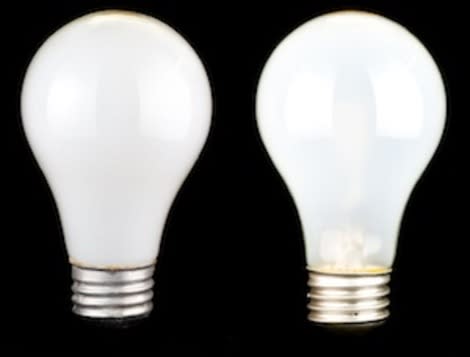The Truth About the New Light Bulb Law

On January 1, 2012 a law phasing out standard 100-watt incandescent bulbs will go into effect. However, it won't be the bulb apocalypse that some detractors have been warning of. In short: the notion that incandescent bulbs will no longer be available is a myth. Nor will you be forced to buy Compact Fluroescent Lightbulbs (CFLs). "You will still be able to buy incandescents," Noah Horowitz, senior scientist at the Natural Resources Defense Council (NRDC), told Yahoo! Shine. "The only difference being that the new and improved ones are more efficient."
The new incandescent bulbs operate and look just like the old-fashioned bulbs that you are used to-they have the same shape and base design. And, according to Horowitz, most people won't notice any difference in the color or quality of light. What is different is that they have an improved filament design, which makes them 28% more efficient as the law requires. So, when you are bulb shopping for replacements for your old 100-watt incandescents, look for new ones labeled "72-watt soft white." Sylvania, Philips, and GE all make similar versions.
The Federal Trade Commission has revised its labeling requirements for most light bulb packages, which might initially cause some confusion. All new bulbs will be labeled prominently with lumens in addition to watts. Watts measure power used, lumens measure the amount of light emitted. Since CFLs, LEDs and other types of bulbs vary in wattage, the most accurate way to look for new efficient bulbs that give off the same amount of light you are used to and prefer is by lumens. The approximate equivalents for old standard incandescents are:
40 watts=450 lumens
60 watts = 800 lumens
75 watts = 1100 lumens
100 watts= 1600 lumens
The new light bulbs do cost more, but will save you money over their lifetime. On average, a new incandescent bulb will cost $1 to $2 compared to 25 cents. That may seem like a big jump, but the NRDC estimates that you will actually save $3 to $3.50 over the life of each bulb--which means they pay for themselves. The average homeowner using all efficient lighting will save $100 to 200 per year on energy costs. That adds up to a savings of $13 billion per year in the United States. New bulbs also reduce pollution. Upgrading our nation's lighting will cut the need for 30 large power plants and reduce carbon pollution by the same amount as taking 17 million cars off the road.
New incandescent bulbs aren't your only option. All major retailers, such as Home Depot, Lowe's, and Target, sell a range of bulbs that meet the new energy standards including the improved incandescents, CFLs, and LEDs. Compact fluorescent bulbs are the cheapest, while LEDs are the most expensive but last for as long as 25 years.
Here are some more shopping tips from Horowitz:
1. Look for "warm white" CFLs and LEDs. Most people prefer "warm white" over those marketed as "cool white" or "day light."
The Environmental Protection Agency offers detailed information on buying the right CFLs for your needs
2. Not all new bulbs are dimmable. If you are replacing a bulb that was in a dimming circuit, make sure to buy a new incandescent or a CFL bulb specifically labeled dimmable.
3. Not all new bulbs are created equal. To ensure you are getting the highest quality product, choose bulbs with the Energy Star label, which meet strict performance requirements.
4. Dispose of bulbs properly. You can throw incandescents and LEDs in the trash. To dispose of CFLs, which contain a very small amount of mercury (less than what's in a can of tuna), place them in a plastic ziploc bag and bring to a Lowes's, Home Depot, or IKEA for free recycling.
The NRDC has a simple light bulb buying guide you can print and bring to the store.
Old incandescents will not be taken off store shelves on January 1, but phased out as they are sold off. The old 75-watt incandescent bulbs will be phased out in 2013 and the 60 and 40-watt bulbs in 2014. Horowitz points out that that new law has spurred innovation: "Without the law, we'd still be stuck with the 125-year-old technology that was so inefficient 90% of the electricity used was wasted as heat."
UPDATE: The omnibus spending deal cut by congress on Friday, December 16 in order to fund the federal government through September, 2012 included a rider to block the Department of Energy from spending money to enforce the new light bulb efficiency rules for nine months. Horowitz told Yahoo! Shine, "The standards remain fully intact and manufacturers and retailers are proceeding full speed ahead in their transition to energy saving light bulbs. At most, this is a mere speed bump along the way."
Photo courtesy of Anthony Clark (NRDC)
Related links:
